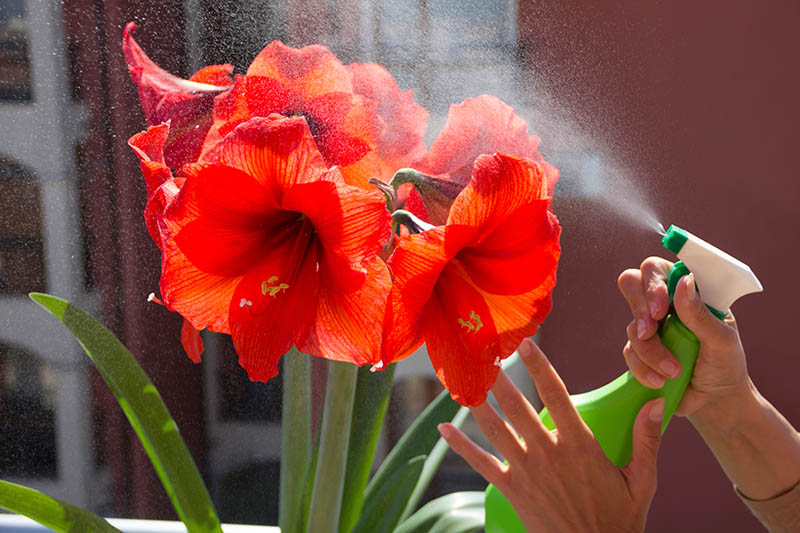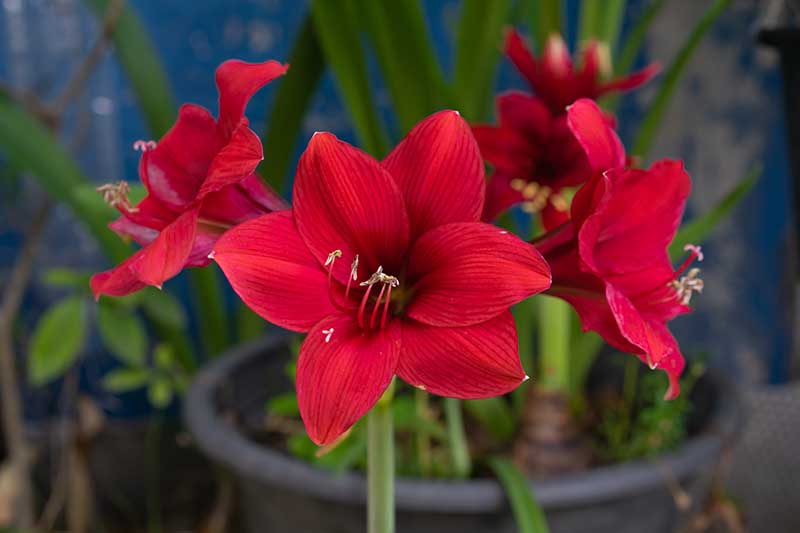The word amaryllis actually derives from the Greek amarysso or “to sparkle,” and this common name is certainly fitting. But what should you do when your plants lack their usual luster, and your decorative winter plants show signs of rot instead, with mushy crowns or collapsing foliage? We link to vendors to help you find relevant products. If you buy from one of our links, we may earn a commission.
Whether you’re aiming to grow gorgeous indoor plants throughout the holiday season or at some other time of year, this guide will help you to prevent rot in your amaryllis bulbs both indoors in containers, or planted outdoors in the landscape in warmer regions. Here’s what we’ll cover:
1. Inspect Before Planting
First and foremost, be sure to purchase high-quality bulbs that are guaranteed to be free of disease, from reputable sellers. And avoid planting those that show signs of damage, to avoid future disappointment as well as the potential spread of pests or disease.
If yours came already potted, remove any packing material or Spanish moss and take a peek at the soil. If it’s already oversaturated, drains poorly, or exhibits other potential issues that aren’t conducive to growing these houseplants, you might want to consider repotting to provide the best possible conditions. If the soil looks and feels alright, take a look at the top of the bulb that is emerging from the soil. Does it look healthy? Is it firm? Is green growth already emerging? These are good signs! But if you observe discolored or moldy portions, signs of insect infestation, growth that has emerged but yellowed or died, or soft, squishy areas, these are signs that your plant was not treated properly in packaging or shipment. Though it may potentially be saved, it’s not off to a good start. Contacting the seller is recommended, if possible. Otherwise, this is no fault of your own, and you may wish to toss this plant and start over. If you purchase unpotted bulbs, these are the easiest to check for potential signs of trouble. Examine them closely before you plant them, and gently squeeze them to make sure there are no soft spots. Check for uniform color, and a firm texture. These are indications of a healthy bulb. Any signs of physical damage, mold, or pest infestation are red flags that your bulb is unfortunately a prime candidate for rot issues. It’s okay if the outer skin is shriveled or rust-brown. They will plump up once you have planted them and given them a drink of water.
Avoid planting any that are bruised or that have been stored in a damp place. If they are soft or show signs of rot right from the start, it’s not likely that they will fare well throughout the season. Red blotch disease, caused by Stagonospora curtissi fungi, may cause red blotches on the skin of bulbs that spread and lead to rot. Dispose of any that exhibit blotches that extend beyond the skin. Southern blight is another fungal disease that may cause bulb rot, but symptoms are generally difficult to monitor prior to planting or before green growth has emerged. Caused by Sclerotium rolfsii fungi, this white mold strikes in hot and wet conditions. But unfortunately, bulbs will rarely show discernible signs of this disease. You’re more likely to observe wilted or dying plants – after it’s already too late to save them. You can read more about this condition here. Pest infestation is another potential problem to watch out for, since tiny pests like mites and mealybugs can also create conditions that lead to rot. When these pests infest amaryllis bulbs, they penetrate the protective outer covering of those in storage, paving the way for pathogens that may cause an infection that ultimately leads to rot.
Check for cottony mealybugs. Feeling the texture is another useful measure here – while small pests may go unnoticed, the damage they cause can be more easily observed as bruised or soft areas. Narcissus bulb flies (Merodon spp.) may also be a problem in gardens and nurseries. Amaryllis may serve as hosts to these pests in gardens, a favored spot for the adult flies to lay their eggs. They hatch into maggots that feast on the outer scales of the bulbs, and then eat their way inside. Examining for soft or bruised portions is your best bet to check for this pest as well, and bulbs may otherwise appear to have nothing wrong with them upon visual inspection of the exterior. Because the narcissus bulb fly is a difficult pest to control, this is yet another reason to dispose of mushy or rotten bulbs in the trash rather than planting them in pots, or out into the garden.
2. Water Carefully
Another of the most common reasons that amaryllis bulbs succumb to rot is thanks to overwatering. Many eager indoor gardeners will hurt their holiday bulbs with a little too much love. Hopefully my recommendations here will help you to avoid this disappointment.
As tempting as it may be to nurse your bulbs along with constant watering, you should avoid overwatering newly planted ones at all costs. When you plant an amaryllis bulb, or receive a potted plant, water it just once with room temperature water, thoroughly wetting the potting medium. Then leave it alone until you see green growth. Really. Leave it alone, entirely. In most conditions, this is all it will need to start. A warm location is best, and you can move it to a sunny spot following the emergence of foliage. For more information on growing these plants, see our guide to growing amaryllis indoors. After green growth emerges, water only after you check and determine that the top several inches of the potting medium have dried out, not before. I’ve found these don’t typically require watering as frequently as many of my other houseplants, and you want to be sure to monitor the plant and the soil conditions rather than watering on a set schedule. You don’t want to allow the potting medium to dry out entirely either, but oversaturation really is the enemy here, and bulbs can rot easily if they’re overwatered. Outdoors, they will not typically require any water in the winter when they are dormant, and they will often revert to blooming in the spring instead. Follow the watering instructions in our guide to growing amaryllis outdoors. Be sure to remove and dispose of any water that has collected in the saucer below your plant, if you have one to catch whatever comes out of the drainage holes. If you have the misfortune of overwatering and this results in a soft and squishy bulb that has begun to show signs of rot at the crown, you may be able to save it by digging it up and carefully removing the rotten portions, or treating it with a systemic fungicide. But for houseplants grown as annuals, prevention is really key.
3. Assess Outdoor Conditions
If you plant your amaryllis in a shaded location, or one that does not drain well, you are asking for trouble. As with most flowering bulbs, full sun conditions are best, in a location with adequate airflow and drainage. Amaryllis plants in the Hippeastrum genus are suited to growing outdoors year-round in USDA Hardiness Zones 11-12, but they will fail to thrive in colder climates. Planting outside the suitable range of gardening areas can lead to rot thanks to cold or fluctuating warm and cold temperatures, frost damage, and excessive precipitation. Water too frequently, water during dormancy, or overwatering at other times of year, and they will be particularly susceptible to fungal infections and pest infestation outdoors. Prevent rot by providing the conditions they need to thrive, on the other hand, and they may provide years of enjoyment with their beautiful blooms. Though yours may not be record-breakers, with proper care, you should be able to coax yours to bloom beautifully without any fear of rotting.
While there isn’t much you can do to prevent southern blight, and any type of pest infestation introduced at the plant nursery is out of your hands, the most common cause of rot can be avoided simply – by watering with care! Have you had problems with rotting amaryllis bulbs, or did you coax yours to blossom as part of your holiday decor? Please share your stories (and photos!) in the comments below, and feel free to reach out if you have any questions that we can help with. For even more tips on growing beautiful amaryllis flowers, read these guides next:
17 Awesome Amaryllis Varieties to Grow Indoors or Out How to Propagate Amaryllis Bulbs How to Grow Amaryllis (Hippeastrum) from Seed
© Ask the Experts, LLC. ALL RIGHTS RESERVED. See our TOS for more details. Uncredited photos: Shutterstock. With additional writing and editing by Allison Sidhu.






